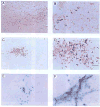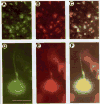General strategy for constructing large HSV-1 plasmid vectors that co-express multiple genes
- PMID: 11464513
- PMCID: PMC2581878
- DOI: 10.2144/01311dd05
General strategy for constructing large HSV-1 plasmid vectors that co-express multiple genes
Abstract
Herpes simplex virus type 1 (HSV-1) plasmid vectors have a number of attractive features for gene transfer into neurons. In particular, the large size of the HSV-1 genome suggests that HSV-1 vectors might be designed to co-express multiple genes. Here, we report a general strategy for constructing large HSV-1 plasmid vectors that co-express multiple genes. Each transcription unit is linked to an antibiotic resistance gene, and genetic selections are used to assemble large vectors. Using this strategy, we constructed large (26 or 31 kb) HSV-1 vectors that contain two transcription units and two or three genes. These vectors were efficiently packaged into HSV-1 particles using a helper virus-free packaging system. The resulting vector stocks supported the expression of two or three genes in both cultured cells and the rat brain. Potential applications of HSV-1 vectors that co-express multiple genes are discussed.
Figures



Similar articles
-
Fifty-one kilobase HSV-1 plasmid vector can be packaged using a helper virus-free system and supports expression in the rat brain.Biotechniques. 2000 Jan;28(1):102-7. doi: 10.2144/00281st05. Biotechniques. 2000. PMID: 10649778
-
Long-term inducible expression in striatal neurons from helper virus-free HSV-1 vectors that contain the tetracycline-inducible promoter system.Brain Res. 2006 Apr 14;1083(1):1-13. doi: 10.1016/j.brainres.2006.01.124. Epub 2006 Mar 20. Brain Res. 2006. PMID: 16545782 Free PMC article.
-
Helper virus-free herpes simplex virus-1 plasmid vectors for gene therapy of Parkinson's disease and other neurological disorders.Exp Neurol. 1997 Mar;144(1):98-102. doi: 10.1006/exnr.1996.6394. Exp Neurol. 1997. PMID: 9126158 Review.
-
Enhanced reporter gene expression in the rat brain from helper virus-free HSV-1 vectors packaged in the presence of specific mutated HSV-1 proteins that affect the virion.Brain Res Mol Brain Res. 2001 May 20;90(1):1-16. doi: 10.1016/s0169-328x(01)00059-6. Brain Res Mol Brain Res. 2001. PMID: 11376851
-
[Herpes simplex type-1 virus-based vectors for gene therapy].Nihon Rinsho. 2000 Apr;58(4):822-7. Nihon Rinsho. 2000. PMID: 10774201 Review. Japanese.
Cited by
-
Coexpression of tyrosine hydroxylase, GTP cyclohydrolase I, aromatic amino acid decarboxylase, and vesicular monoamine transporter 2 from a helper virus-free herpes simplex virus type 1 vector supports high-level, long-term biochemical and behavioral correction of a rat model of Parkinson's disease.Hum Gene Ther. 2004 Dec;15(12):1177-96. doi: 10.1089/hum.2004.15.1177. Hum Gene Ther. 2004. PMID: 15684695 Free PMC article.
-
Genetic enhancement of visual learning by activation of protein kinase C pathways in small groups of rat cortical neurons.J Neurosci. 2005 Sep 14;25(37):8468-81. doi: 10.1523/JNEUROSCI.2271-05.2005. J Neurosci. 2005. PMID: 16162929 Free PMC article.
-
Characteristic and intermingled neocortical circuits encode different visual object discriminations.Behav Brain Res. 2017 Jul 28;331:261-275. doi: 10.1016/j.bbr.2017.05.016. Epub 2017 May 13. Behav Brain Res. 2017. PMID: 28511982 Free PMC article.
-
Isolation of an enhancer from the rat tyrosine hydroxylase promoter that supports long-term, neuronal-specific expression from a neurofilament promoter, in a helper virus-free HSV-1 vector system.Brain Res. 2007 Jan 26;1130(1):1-16. doi: 10.1016/j.brainres.2006.10.018. Epub 2006 Dec 13. Brain Res. 2007. PMID: 17169349 Free PMC article.
-
Overexpression of either lysine-specific demethylase-1 or CLOCK, but not Co-Rest, improves long-term expression from a modified neurofilament promoter, in a helper virus-free HSV-1 vector system.Brain Res. 2012 Feb 3;1436:157-67. doi: 10.1016/j.brainres.2011.12.011. Epub 2011 Dec 13. Brain Res. 2012. PMID: 22208646 Free PMC article.
References
-
- Chung JH, Whiteley M, Felsenfeld G. A 5′ element of the chicken β-globin domain serves as an insulator in human erythroid cells and protects against position effect in Drosophila. Cell. 1993;74:505–514. - PubMed
-
- Fotaki ME, Pink JR, Mous J. Tetracycline-responsive gene expression in mouse brain after amplicon-mediated gene transfer. Gene Ther. 1997;4:901–908. - PubMed
-
- Geller AI. Genetic analysis of the role of protein kinase C signaling pathways in behaviors by direct gene transfer with HSV-1 vectors. Rev Neurosci. 1999;10:1–13. - PubMed
Publication types
MeSH terms
Grants and funding
LinkOut - more resources
Full Text Sources
